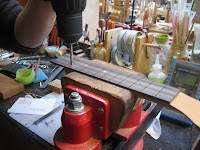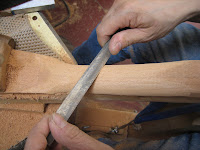




Today we continue with shaping the nut and aligning the bridge where it will be placed.
1. Mike takes a bone nut (approximately 1/8th”) and uses it as a fence against the “0” fret and with a razor saw cuts a slot into the peghead wood overlay to receive the nut. Keeping the razor saw against the nut it will cut a perfect slot size to receive the nut. The slot is then routed out with a narrow chisel or in Mike’s case a file which has been grounded down.
2. Mike then bevels the bottom of the nut to a 15 degree angle to match the angle of the peghead.
3. The nut is put into its slot checking to see if it is seated properly and then Mike takes a scraper blade, lays it down on the frets and with a fine pencil draws a line across the nut. This is the mark for the height of the nut. He also draws lines where the sides of the nut should be cut off.
4. The nut is taken over to the belt sander and Mike sands off the height to the line just drawn and takes down the sides angling them slightly but leaves the sides of the nut just a little proud of the sides of the neck. Final shaping is done after nut is in slot.
5. After nut is all rounded over on all sides except the bottom edges it is placed into its slot to check the fit. If it is exactly like you want it, put just one little tiny drop of CA glue into the middle of the slot and place nut into slot. You want just a little glue just in case at the later time the nut needs to be replaced or worked on it will be able to be taken out of its slot.
Then, while the nut is in its slot with the neck clamped in sideways into a vise, very carefully file the nut edges so they are flush with the neck. Be careful not to file the neck!
Now to get the bridge placement ready…
1. Put a straightedge down the center of the ukulele and find what measurement you need for bridge placement. You can go online and put in your scale (mine’s 15” scale) and find the bridge placement number you need from the 12th fret. Because of string compensation you will need to place it a little farther back than just 7 ½”. Mine happens to be 7.545”. Here’s the link to the fret calculator:
http://windworld.com/features/tools-resources/exmis-fret-placement-calculator/2. You also want to check the bridges center placement. Mike does this by laying a straightedge down the fretboard centering its top edge against the nut and then checks with a caliper the remaining wood at the sides showing at the 12th fret. Both sides should be the same. Then he checks the bottom edge of the straightedge making sure the bridge lines up with the center of the straightedge.
3. When bridge is centered and at the right placement (here you will want to double, triple check the placement) place a strip of masking tape (3M lime green) right in front of the bridge. This is your bridge placement line. Also do the sides and one in the back.
4. Mike then takes off the bridge and covers the bare wood in the middle where the bridge was with another strip of tape. Bridge is placed back on soundboard and with a new sharp exacto blade scores the tape around the bridge. Outside tape that marked bridge placement is now gently pulled off and voila you have the shape of your bridge that will now be masked for the spray finish.
5. Bridge’s string placement lines are redrawn ( mine got rubbed off when decorative shaping). Use little corner tool to draw lines around corner. Holes are drilled at the bottom of the bridge for the string knots. Drill about a ¼” down. Bridge is then placed in a vise and lines are sawn with a razor saw down in front of the holes for strings to come out in front of bridge. Next file the slots for the strings with their respective nut slot files.
6. Mike then drills two holes into the back of the bridge where it will be glued to the soundboard. Use a really small drill (maybe 1/64th bit). He then takes a tack (clear plastic head) and nips the pointy part off (1/8th”) and sticks the cut blunt end into the bridge so the pointy part sticks out. Do this for the other hole. The bridge is then placed over the tape that is shaped like the bridge and presses it down over the tape just to mark the tape. Then Mike uses a small drill bit to drill into the soundboard. The bridge is placed into the two holes and Mike shows me how well the bridge is secure to the soundboard.
7. Mike now covers the fretboard with the same green tape putting a length down one side up and over the nut and the end of the fretboard and then repeats for the other side. He lines up a scraper blade up to the peghead side of the nut and carefully scores and then tears away the tape from the peghead. He then does this to the fretboard end. As tape is placed over fretboard be sure to run a finger nail at each fret so tape is touching all of the fretboard. We don’t want any finish to get on the fretboard.
8. He then planes and files the back of the heel flush to the back of the uke. Be careful to only file the heel so as not to mar up the back with new file marks.
9. Then Mike goes over the whole body of the uke with the orbital sander with 150 grit. He then goes to 320 grit after that.
It’s almost finished! Next time the orchid ukulele will get its finish!



















































